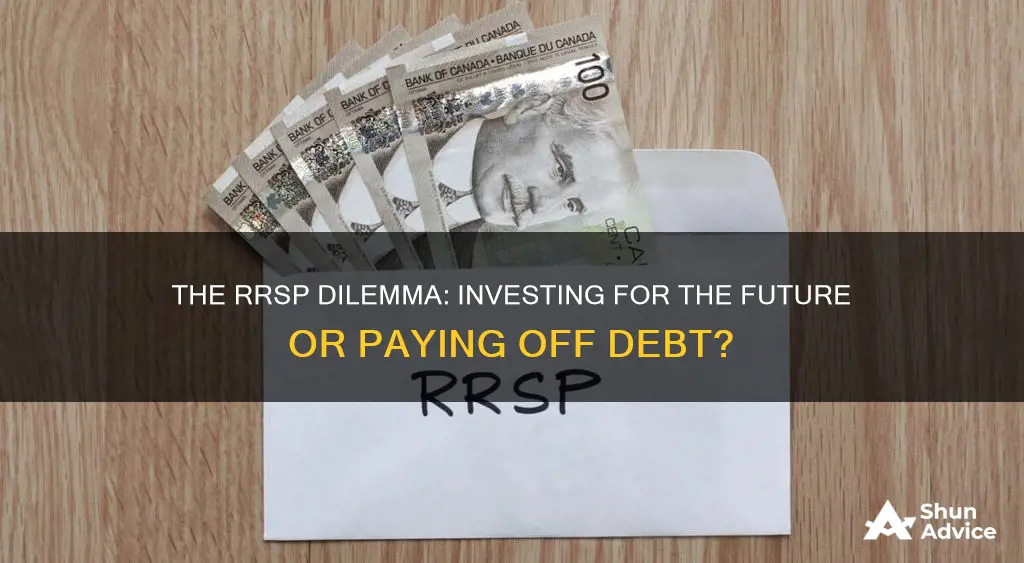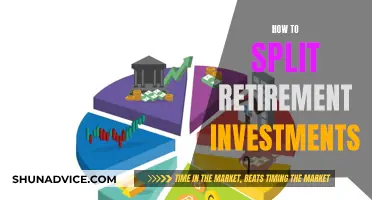
If you have extra cash and are thinking about investing, but you're also carrying debt, it's important to weigh your options carefully. While investing in an RRSP can be a good strategy for retirement planning, paying off debt should also be a priority. Here's a look at some things to consider when deciding whether to invest in an RRSP or pay off debt.
| Characteristics | Values |
|---|---|
| Priority | Paying off debt vs investing is a big dilemma for early career professionals. |
| Pros of paying off debt | No investment risk, tax-free repayment, higher after-tax return compared to a tax-exposed investment, helps build good investing habits |
| Cons of paying off debt | Requires discipline to stick to a long-term plan, may not be suitable for those with a high income and low cost of living |
| Pros of investing in RRSPs | Designed for retirement planning, can be used to pay for your first home or finance your education, can be used to pay off debt in certain exceptional circumstances |
| Cons of investing in RRSPs | Withdrawing before retirement has consequences such as withholding tax, exit fees, income tax, loss of contribution rights, and jeopardising your retirement |
What You'll Learn
- RRSPs are designed for retirement planning
- Paying off high-interest credit card debt should be prioritised
- The Avalanche Method: Focus on clearing debt with the highest interest rate first
- Debt consolidation: Combine all debt into one loan with a single monthly payment
- Withdrawing from RRSPs before retirement has consequences

RRSPs are designed for retirement planning
RRSPs, or Registered Retirement Savings Plans, are designed for retirement planning. They are a type of retirement savings and investment vehicle available to employees and self-employed individuals in Canada. RRSPs were created in 1957 as part of the Canadian Income Tax Act and are registered with the Canadian government, overseen by the Canada Revenue Agency (CRA).
RRSPs offer tax advantages to contributors. Firstly, contributors may deduct contributions against their income. For example, if a contributor's tax rate is 40%, every $100 they invest in an RRSP will save them $40 in taxes, up to their contribution limit. Secondly, the growth of RRSP investments is tax-deferred. This means that, unlike with non-RRSP investments, returns are exempt from any capital gains tax, dividend tax, or income tax.
There are several types of RRSPs, including individual, spousal, group, and pooled plans. A wide range of investment options are permitted within an RRSP, such as mutual funds, exchange-traded funds, individual stocks, and bonds. The contribution limit for RRSPs is set by the CRA and is based on the contributor's earned income. It is important to note that contributions can be made at any age.
In summary, RRSPs are a tax-advantaged savings and investment vehicle designed to help Canadians plan for retirement. They offer flexibility in terms of contribution types and investment options, making them a popular choice for those looking to secure their financial future.
Riches in Art: Where the Wealthy Invest
You may want to see also

Paying off high-interest credit card debt should be prioritised
When deciding whether to invest in an RRSP or pay off debt, it's important to consider your financial situation and goals. While investing in an RRSP can be a great way to save for retirement, paying off high-interest credit card debt should be a priority. Here's why:
High Interest Rates
The first reason to prioritise paying off credit card debt is the high interest rates associated with credit cards. Most credit cards charge high interest rates, often as much as 18% or more, if you don't pay off your balance in full each month. These interest rates can quickly add up, making it difficult to get out of debt. By paying off your credit card debt first, you can avoid these high interest charges and save money in the long run.
No Investment Matches High Interest Rates
Another reason to focus on paying off credit card debt is that no investment will typically give you returns that match the high interest rate on your credit card. For example, if you have a credit card with an 18% interest rate, it is unlikely that any investment will provide you with an 18% return. Therefore, by eliminating your credit card debt first, you can ensure that you are not losing money to high interest charges.
Tax-Free Debt Repayment
In addition to the high interest rates, credit card debt can also impact your taxes. When you pay off credit card debt, you are doing so with after-tax dollars. This means that the money you use to pay off the debt has already been taxed, and you don't get any tax benefits for making those payments. By contrast, investing in certain vehicles, like a Tax-Free Savings Account (TFSA), can provide tax advantages. Therefore, by prioritising credit card debt repayment, you can free up more money to invest in tax-advantaged accounts and maximise your returns.
Improved Cash Flow and Financial Stability
Paying off high-interest credit card debt can also improve your cash flow and overall financial stability. When you eliminate credit card debt, you reduce the amount of money you need to pay each month in interest and principal payments. This frees up more of your income to save, invest, or use for other financial goals, such as buying a house. Additionally, reducing debt can improve your debt-to-income ratio, which is an important factor in your overall financial health and can impact your ability to obtain loans or mortgages in the future.
Peace of Mind and Reduced Stress
Finally, prioritising credit card debt repayment can provide peace of mind and reduced financial stress. Carrying high-interest credit card debt can be a significant source of anxiety and worry. By making it a priority to pay off this debt, you can improve your mental well-being and gain a sense of financial control. This can lead to better financial decision-making and a more positive outlook on your financial future.
In conclusion, while investing in an RRSP is an important part of retirement planning, it is generally advisable to prioritise paying off high-interest credit card debt first. By doing so, you can save money on interest charges, maximise your investment returns, improve your cash flow, and reduce financial stress. Once you have eliminated your high-interest debt, you can then focus on investing for the long term through vehicles like RRSPs or TFSAs.
Germans' View on Chinese Investments
You may want to see also

The Avalanche Method: Focus on clearing debt with the highest interest rate first
The Avalanche Method is a debt repayment strategy that involves focusing on clearing the debt with the highest interest rate first. This strategy is designed to help individuals reduce the total interest they pay over time and get out of debt faster. Here's how it works:
- Make a list of all your debts along with their individual interest rates.
- Determine an amount from your monthly income that can be allocated towards debt repayment. This amount should be separate from the funds needed for living expenses such as rent, groceries, transportation, etc.
- Make minimum payments on all your debts to avoid late fees and penalties.
- Allocate any remaining funds towards the debt with the highest interest rate. Ensure that the payment is significant but still within your budget.
- Continue making minimum payments on your other debts until the highest interest rate debt is cleared.
- Once the first debt is paid off, shift your focus to the debt with the second-highest interest rate. Add the amount you were paying towards the first debt on top of the minimum payment for the second debt.
- Repeat this process until all your debts are cleared.
The Avalanche Method takes time and discipline to be effective. It may be challenging to stick to this strategy, especially if your highest-interest debt also has the highest balance. However, by targeting debts with the highest interest rates first, you can potentially save a significant amount of money in interest charges over time. This method also provides some motivation as you are getting rid of the most costly debt first.
Investing: Why the Delay?
You may want to see also

Debt consolidation: Combine all debt into one loan with a single monthly payment
Debt consolidation is a debt management strategy that can help simplify payments and improve your creditworthiness. It involves combining multiple debts into a single loan with a fixed interest rate and a single monthly payment. This can make your debt more manageable and reduce the stress of having multiple payment schedules.
- *Gather Billing Statements:* Collect all your outstanding balances and identify the monthly payment amounts and interest rates. Create a budget and understand how much money you can allocate towards debt repayment each month.
- *Calculate Your Total Debts:* Calculate the total amount of your existing debts, their interest rates, payment amounts, and due dates. This will help you choose a lender with sufficient borrowing limits and identify a repayment term that fits your budget.
- *Compare Consolidation Options:* Research options such as balance transfers or personal loans. Compare qualification requirements, interest rates, and repayment terms. Use a loan consolidation calculator to determine potential savings. Many online lenders offer pre-qualification without a hard credit inquiry.
- *Submit an Application:* Start the formal application process with your chosen lender. For a personal loan, this may involve providing financial information such as tax returns and bank statements. Credit card applications are typically more straightforward and offer instant credit decisions.
- *Pay Off Individual Balances:* Use the funds from your consolidation loan or balance transfer to pay off all other debts. Ensure there are no remaining balances before closing old accounts. If you're consolidating credit card balances, consider leaving the cards open to maintain your available credit, but avoid using them.
Benefits of Debt Consolidation:
Debt consolidation offers several advantages:
- Simplifies Debt Management: It combines multiple debts into one loan with a single payment, making it easier to track your progress.
- Reduces Stress: Having a single monthly payment with one set of fees and a single interest rate can reduce the stress associated with managing multiple loans or credit cards.
- Potentially Lower Interest Rates: The combined loan often has a lower interest rate than separate accounts, which can lead to long-term savings.
- Makes Budgeting Easier: By eliminating separate balances, you can focus on reducing your total debt more efficiently.
Drawbacks of Debt Consolidation:
However, there are also some potential downsides to consider:
- Restructuring Debt: Consolidating bills doesn't eliminate debt; it restructures your payments to make them more manageable.
- Potential for Higher Interest Rates: If you obtain a consolidation loan or credit card with a higher interest rate than your current individual rates, it could cost you more in the long run.
- Longer Repayment Period: Lower monthly payments may be due to an extended repayment period, resulting in paying more overall.
- Fees and Costs: Consolidation loans may come with fees and costs that weren't present with your previous individual payments.
- Risk with Home Equity Loans: Using a home equity loan for debt consolidation is risky. Failure to repay the loan could result in losing your home, and you may not have home equity available for emergencies or other expenses.
The 7-Year Investment Itch: When Do Long-Term Investments Pay Off?
You may want to see also

Withdrawing from RRSPs before retirement has consequences
Withdrawing from your RRSP before retirement can have several consequences. Firstly, you will likely face tax implications. The amount you withdraw will be considered taxable income, resulting in a higher income tax payment for that year. Additionally, your financial institution will withhold a portion of the withdrawal as tax, with rates ranging from 10% to 30% depending on the amount withdrawn and your location. These withholding tax rates are lower in Quebec, but provincial tax rates also apply.
Secondly, you will lose the contribution room you originally used to make your RRSP contribution. This reduces the potential value of your RRSP when you retire, as you can no longer replace the amount you withdrew. Early withdrawals also mean missing out on the benefits of compound interest, where the interest earned on your savings also earns interest over time.
Finally, withdrawing from a locked-in RRSP plan before retirement is usually not permitted. While it is possible to take money out of most RRSPs at any time, doing so should be a last resort due to the tax consequences and the loss of contribution room.
Tether: The Stablecoin Advantage
You may want to see also
Frequently asked questions
RRSP stands for Registered Retirement Savings Plan. RRSPs are designed for retirement planning and allow Canadians to put capital into investments to help save for retirement.
One pro of investing in an RRSP is that you can subtract the amount you contribute from your income and pay less in income taxes. However, a con is that withdrawing money from your RRSP before retirement can lead to a withholding tax, exit fees, and income tax.
One pro of paying off debt is that debt repayment has no investment risk. A con of paying off debt is that it may not be the best use of your money if you have a low-interest rate.
One alternative is a Tax-Free Savings Account (TFSA). A TFSA is tax-free and can be a great place to start investing.







